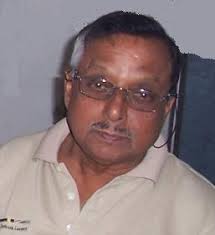Biography:Hanumant Shankar Sawant
Hanumant Shankar Sawant (born 13 August 1939) is a radio astronomer and one of the pioneers of the Brazilian solar radio astronomy. He has been the key scientist behind concept, design and installation of the Brazilian Decimetric Array (BDA).[1] Under his leadership, an outstanding group in radio astrophysics has been built at National Institute of Space Research (INPE) in Brazil.[2]
Hanumant Shankar Sawant | |
|---|---|
 | |
| Born | 13 August 1939 Pune (prior to 1939) |
| Nationality | Indian |
| Citizenship | Brazilian |
| Alma mater | Fergusson College |
| Known for | Brazilian Decimetric Array (BDA) |
| Scientific career | |
| Doctoral advisor | Rajaram Vishnu Bhonsle |
Early life and education
Hanumant Sawant was born at Pune, India in 1939. He received BSc degree in Electronics and Communications Engineering from University of Bombay in 1964 and MSc in Physics in 1971 from the Ahmedabad University, and PhD in Physical Sciences from Physical Research Laboratory (PRL) in 1977. He was at the Department of Astronomy of University of Maryland (1978–1979) and Space Science Laboratory of University of California, Berkeley, USA (1980–1981). In 1982, he became Associate Researcher of the National Institute for Space Research (INPE) in Brazil. He became Project Director of the BDA in 2002 and retired from INPE in 2015.[citation needed]
Major contributions
His main contributions involved observational and theoretical precursor studies of fine structures in solar noise storms at decametric frequencies and high-energy solar flares, in collaboration with leading scientists such as R.V. Bhonsle, S.K. Alurkar, S.S. Degaonkar, M. Kundu, P. Kaufmann and S.R. Kane.[3][4][5][6] In 1982 he participated in the innovative investigation on the interplanetary effects of solar flares occurred in 1979 when after, in 1984, he published the results [7] in partnership with S.R. Kane and A. Hewish the Nobel Prize winner in physics in 1974. This was pioneering work in the scientific field that is now known as the space weather.
He was the main researcher for the development of the following instruments in solar radio astronomy: ROI Millimeter Radiometer (18–23 GHz) - Itapetinga Radio Observatory (Atibaia, SP),[8] Decimetric Solar Spectrometer (1.2-1.7 GHz), Brazilian Solar Spectroscope (BSS) (1.0-2.5 GHz)[9] and Brazilian Decimetric Array (BDA), for which he has served as General Coordinator since 2001.
Personal life
Prof. Hanumant Sawant is married to Ratna Sawant and resides in São José dos Campos, state of São Paulo, Brazil. He has one daughter, Vidula Sawant and one son. His son, Abhijit Sawant is married to Sandra. He is the grandfather of Kyle, Enzo and Enya.
References
- ↑ Sawant, H. S.; Gopalswamy, N; Rosa, R. R.; Sych, R. A.; Anfinogentov, S. A.; Fernandes, F. C. R.; Cecatto, J. R.; Costa, J. E. R. (2011). "The Brazilian decimetric array and space weather". Journal of Atmospheric and Solar-Terrestrial Physics 73 (11–12): 1300–1310. doi:10.1016/j.jastp.2010.09.009. ISSN 1364-6826. Bibcode: 2011JASTP..73.1300S.
- ↑ "Brazilian Decimetric Array (BDA)". http://www.das.inpe.br/fmi/bda/. Retrieved 2010-01-28.
- ↑ Sawant, H. S.; Alurkar, S. K.; Bhonsle, R. V. (1975). "New microstructure of decametre solar radio bursts". Nature 253 (5490): 329–330. doi:10.1038/253329a0. ISSN 0028-0836. Bibcode: 1975Natur.253..329S.
- ↑ Sawant, H. S.; Gergely, T. E.; Kundu, M. R. (1982). "Positions of type II fundamental and harmonic sources in the 30?100 MHz range". Solar Physics 77 (1–2): 249–254. doi:10.1007/BF00156107. ISSN 0038-0938. Bibcode: 1982SoPh...77..249S.
- ↑ Bhonsle, R.V.; Sawant, H.S.; Degaonkar, S.S. (1979). "Exploration of the solar corona by high resolution solar decametric observations". Space Science Reviews 24 (3): 259. doi:10.1007/BF00212422. ISSN 0038-6308. Bibcode: 1979SSRv...24..259B.
- ↑ Sawant, H.S.; Kaufmann, P.; Correia, E.; Costa, J.E.R.; Zlobec, P.; Messerotti, M.; Fornasari, L. (1984). "Association of time structures of solar bursts at millimetric and at metric waves". Advances in Space Research 4 (7): 251–254. doi:10.1016/0273-1177(84)90192-3. ISSN 0273-1177.
- ↑ Kane, S. R. et al. (1984). "Energetics and Interplanetary Effects of the August 14 and 18, 1979 Solar Flares: Summary of Observations Made during the Smy/stip Event no.". Solar/Interplanetary Intervals: 175. Bibcode: 1984sii..conf..175K. https://apps.dtic.mil/dtic/tr/fulltext/u2/a125096.pdf.
- ↑ Sawant, H. S.; Rosa, R. R.; Cecatto, J. R.; Gopalswamy, N. (2016). "Solar Simple Bursts Observed with High Spectral Resolution in the 18-23 GHz Range". International Astronomical Union Colloquium 142: 693–695. doi:10.1017/S0252921100077976. ISSN 0252-9211.
- ↑ Sawant, H.S.; Cecatto, J.R.; Mészárosová, H.; Faria, C.; Fernandes, F.C.R.; Karlický, M.; de Andrade, M.C. (2009). "Highlights of the Brazilian Solar Spectroscope". Advances in Space Research 44 (1): 54–57. doi:10.1016/j.asr.2009.03.019. ISSN 0273-1177. Bibcode: 2009AdSpR..44...54S.
External links
 |

